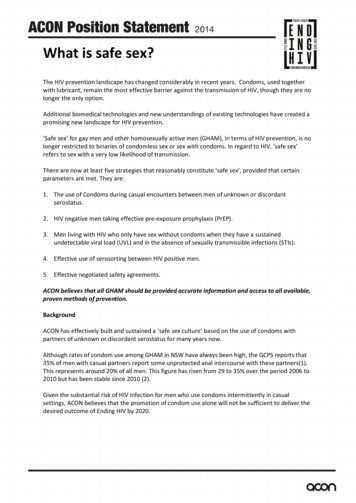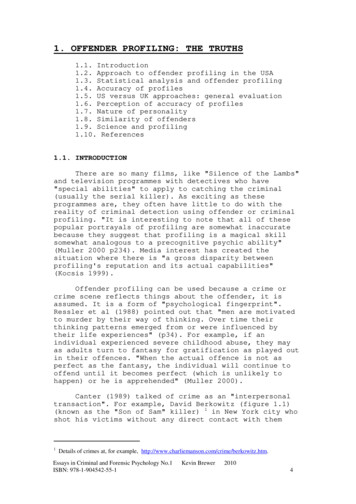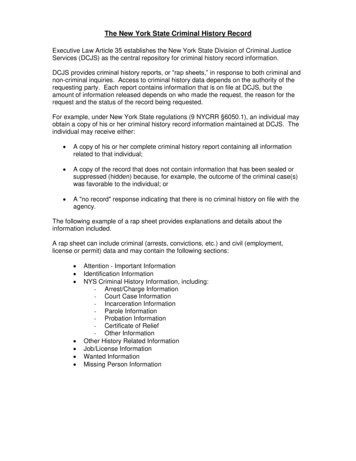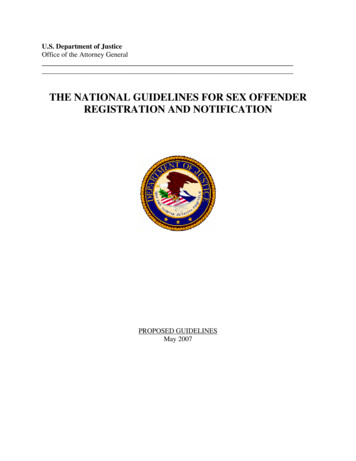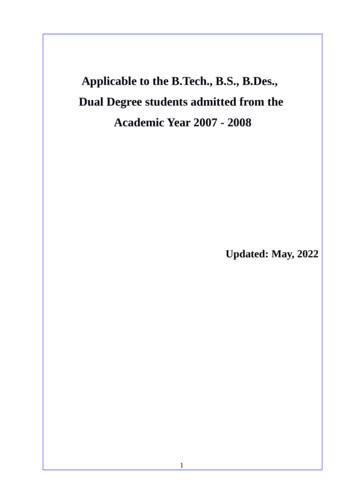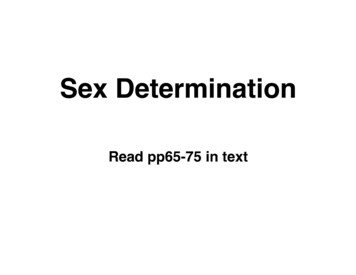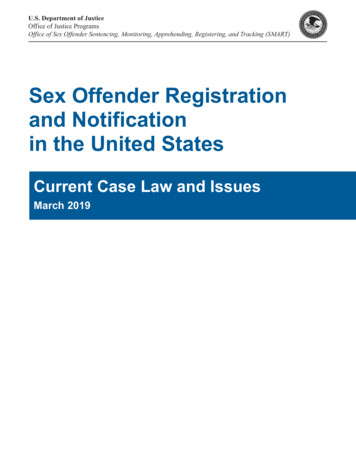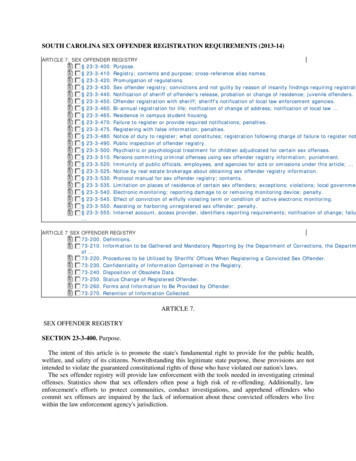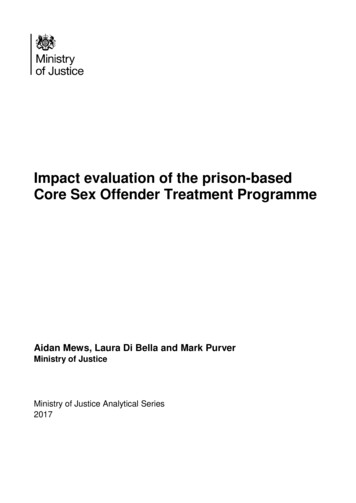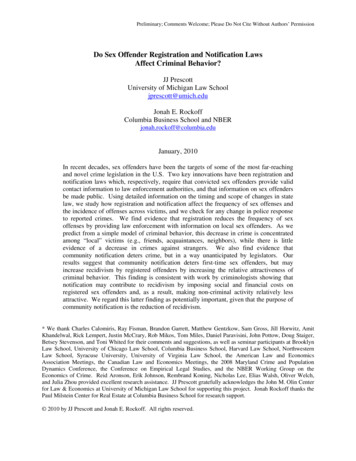
Transcription
Preliminary; Comments Welcome; Please Do Not Cite Without Authors’ PermissionDo Sex Offender Registration and Notification LawsAffect Criminal Behavior?JJ PrescottUniversity of Michigan Law Schooljprescott@umich.eduJonah E. RockoffColumbia Business School and NBERjonah.rockoff@columbia.eduJanuary, 2010In recent decades, sex offenders have been the targets of some of the most far-reachingand novel crime legislation in the U.S. Two key innovations have been registration andnotification laws which, respectively, require that convicted sex offenders provide validcontact information to law enforcement authorities, and that information on sex offendersbe made public. Using detailed information on the timing and scope of changes in statelaw, we study how registration and notification affect the frequency of sex offenses andthe incidence of offenses across victims, and we check for any change in police responseto reported crimes. We find evidence that registration reduces the frequency of sexoffenses by providing law enforcement with information on local sex offenders. As wepredict from a simple model of criminal behavior, this decrease in crime is concentratedamong “local” victims (e.g., friends, acquaintances, neighbors), while there is littleevidence of a decrease in crimes against strangers. We also find evidence thatcommunity notification deters crime, but in a way unanticipated by legislators. Ourresults suggest that community notification deters first-time sex offenders, but mayincrease recidivism by registered offenders by increasing the relative attractiveness ofcriminal behavior. This finding is consistent with work by criminologists showing thatnotification may contribute to recidivism by imposing social and financial costs onregistered sex offenders and, as a result, making non-criminal activity relatively lessattractive. We regard this latter finding as potentially important, given that the purpose ofcommunity notification is the reduction of recidivism.* We thank Charles Calomiris, Ray Fisman, Brandon Garrett, Matthew Gentzkow, Sam Gross, Jill Horwitz, AmitKhandelwal, Rick Lempert, Justin McCrary, Rob Mikos, Tom Miles, Daniel Paravisini, John Pottow, Doug Staiger,Betsey Stevenson, and Toni Whited for their comments and suggestions, as well as seminar participants at BrooklynLaw School, University of Chicago Law School, Columbia Business School, Harvard Law School, NorthwesternLaw School, Syracuse University, University of Virginia Law School, the American Law and EconomicsAssociation Meetings, the Canadian Law and Economics Meetings, the 2008 Maryland Crime and PopulationDynamics Conference, the Conference on Empirical Legal Studies, and the NBER Working Group on theEconomics of Crime. Reid Aronson, Erik Johnson, Rembrand Koning, Nicholas Lee, Elias Walsh, Oliver Welch,and Julia Zhou provided excellent research assistance. JJ Prescott gratefully acknowledges the John M. Olin Centerfor Law & Economics at University of Michigan Law School for supporting this project. Jonah Rockoff thanks thePaul Milstein Center for Real Estate at Columbia Business School for research support. 2010 by JJ Prescott and Jonah E. Rockoff. All rights reserved.
1. IntroductionCriminal recidivism poses a serious risk to public safety. As many as two-thirds ofreleased inmates return to prison within a few years (BJS (2002a)), and data from the NationalCorrections Reporting Program show that approximately 40 percent of all criminals sent to U.S.prisons over the last twenty years were already convicted felons. Recently, victims’ advocatesand others have argued that persons convicted of sex offenses are highly likely to “same crime”recidivate (see Langan et al. (2003) and Vásquez et al. (2008)). Although criminal behaviortypically declines steeply with age after the early twenties, the decline for sex offenses may bemore gradual (Hanson (2002)). Partly for these reasons, and because of a few high-profilecrimes in the late 1980s and early 1990s, sex offenders have become the focus of considerablelegislation and public spending aimed at reducing their recidivism.In the 1990s, two sets of laws targeting sex offenders proliferated across the UnitedStates. A federal mandate in 1994 (the Jacob Wetterling Act, named after the victim of a crimein Minnesota) required that states create registries of sex offenders for use by law enforcement.Another federal mandate in 1996 (Megan’s Law, named after a victim in New Jersey, MeganKanka) required that states provide public notification of the location of sex offenders to localresidents or other “at risk” groups. The basic motivations for registration and notification were,respectively, to aid law enforcement in supervising and apprehending sex offenders who mayrecidivate and to help local households protect themselves through monitoring and avoidingoffenders in their neighborhoods.Despite the widespread use of sex offender registration and notification laws, it is unclearwhether they have been successful in reducing crime by sex offenders, or whether they haveachieved other goals (e.g., increasing the probability of arrest). It is also unknown whether sexoffenders respond (or are able to respond) to these laws in other ways (e.g., selecting theirvictims differently). The answers to these questions are important not only for evaluating thecosts and benefits of registration and notification laws, but also for understanding how animportant group of convicted criminals responds to changes in legal sanctions.11Empirical work provides some support for the claim that criminals in general react to changes in expectedpunishment (e.g., Levitt (1998), Kessler and Levitt (1999), Nagin (1998)). However, it is unclear whether this istrue for all types of individuals (see McCrary and Lee (2005) on juvenile offenders), and whether these resultsextend to sex offenders in particular is unknown (see Bachman et al. (1992)).1
The first studies that sought to measure the impact of registration and notification laws(Schram and Milloy (1995) and Adkins et al. (2000)) compared recidivism rates of offenders inIowa and Washington State released just before and after registration and notification lawsbecame effective. While neither study found a statistically significant difference in subsequentarrests for sex offenses between these two groups, both studies relied on small samples ofoffenders. More recent studies have examined the relationship between the timing of laws’passage and changes in the annual frequency of sex offenses across states using UCR data (Shaoand Li (2006), Agan (2007), and Vásquez et al. (2008)). Taken together, these studies find littleevidence that these laws had a significant impact on the number of sex offenses.2While we also use the timing of changes in state laws to study the impact of those lawson criminal behavior, we are able to offer new evidence on a number of different questionsbecause our analysis differs significantly from earlier work in both the data we use and themethodology we employ. First, we conducted extensive research into the sex offenderlegislation of various states, and found that earlier studies had used incorrect legal dates or hadmischaracterized these laws. Understanding the timing and scope of this body of law is not easy,partially because sex offender laws have changed over time due to legislative amendments andjudicial decisions.3 We also take advantage of information on the exact dates when laws becameeffective by using monthly data and allowing for variation in crime frequency within years, incontrast to the earlier work using annual data.Second, unlike existing work, our analysis distinguishes between sex offenderregistration and notification laws. Notification laws require the dissemination of informationabout sex offenders (e.g., criminal history, physical description, home address, etc.).Registration laws, in contrast, require that sex offenders provide such information to a publicauthority (e.g., local police), but this data is otherwise kept confidential. While registrationrequirements are intended solely to help law enforcement track and apprehend recidivist2Only Shao and Li (2006) report any evidence that offender registration laws caused a statistically significantreduction in sex offenses. However, their findings are sensitive to empirical specification and they groupregistration and notification laws together as a single treatment. Agan (2007) offers some evidence that posting sexoffender information on the internet reduced the number of arrests for sex offenses, but her results are similarlysensitive and open to alternative interpretations.3We describe the history of sex offender registration and notification laws in Section 2 and provide basicinformation on these enactments in Appendix Table 1.2
offenders, notification laws aim both at reducing crime through greater public awareness and byfacilitating capture conditional on the commission of a crime (Prentky (1996), Pawson (2002),Levenson and D’Amora (2007)). We also differentiate among various features of notificationlaws, e.g., access to paper registry, internet access, or proactive community notification.4Third, we use variation in the number of offenders actually registered with authorities toidentify different ways in which registration and notification may influence criminal behavior.For example, the main channel by which notification laws are expected to reduce recidivism isby making the public aware of nearby sex offenders, but they may also reduce crime by raisingthe punishment for first-time sex offenders (whose crimes and personal information will be madepublic upon release if they are caught and convicted). While notification should have little effecton recidivism when registries are empty, the potential effect on first-time or simply unregisteredoffenders should be invariant to the number of offenders actually registered.Finally, we examine the effects of these laws on the relationship mix between offendersand victims in addition to the overall frequency of reported sex offenses. Neither registration nornotification were intended to affect the “incidence” of sex offenses across different types ofvictims, but some observers have suspected that notification laws might simply displace crime bychanging the population of victims targeted by sex offenders (see Prentky (1996), Filler (2001)).We also study changes in the probability that an arrest is made given a reported sex offense, andthat the offense reported is not prosecuted, despite arrest, because the victim refused to cooperateor the prosecution declined to pursue the case for some other reason.We find evidence that actual registration of released sex offenders is associated with asignificant decrease in crime. This is in line with predictions from a simple model of criminalbehavior in which providing information on offenders to local authorities increases monitoringand the expected punishment for recidivism. Moreover, the drop in the overall frequency ofreported sex offenses associated with registration is due primarily to reductions in attacks against“local” victims who are known to an offender (i.e., a family member, friend, acquaintance, or4Shao and Li (2007) do not differentiate between notification and registration laws. Vásquez et al. (2008) stateexplicitly that they examine both “registration and notification” laws, but do not distinguish between the two in theirempirical work. Agan (2007), on the other hand, recognizes the distinction with respect to internet availability ofregistry information, but nevertheless does not include or consider other kinds of notification.3
neighbor). Importantly, sex offenses by strangers appear unaffected by registration, indicatinglittle or no substitution from local to more “distant” victims.We also find that the implementation of a notification law (regardless of the number ofregistered offenders) is associated with a reduction in the overall frequency of sex offenses. Onepotential explanation for this effect, again consistent with our model, is that notification raisesthe punishment for future offenders. Importantly, we find no evidence that notification laws (asopposed to registration laws) reduced crime by lowering recidivism—the estimated effect isactually weaker when a large number of offenders are on the registry. This finding is potentiallyconsistent with a number of explanations. But, as we show below, the evidence on balancesupports the existence of a significant “relative utility” effect, in which convicted sex offendersbecome more likely to commit crime when their information is made public because theassociated psychological, social, or financial costs make crime more attractive.The rest of the paper proceeds as follows. In Section 2, we describe the variation in thetiming and scope of state registration and notification laws. Section 3 lays out the potentialeffects of registration and notification using a simple model of criminal behavior and presentsour basic empirical methodology. Section 4 describes our data. We present our results inSection 5 and robustness checks in Section 6. We conclude in Section 7.2. The Evolution of Sex Offender Registration and Notification LawsTo characterize the sex offender registration and notification laws properly for theempirical work below, we painstakingly researched the evolution of these laws in states coveredin the 1990s by the National Incident Based Reporting System (NIBRS), the data used in ouranalysis below.5 We divide the legal changes we study into four categories: registration, publicaccess, internet availability, and active notification. Registration requires that sex offenders5See the Data Appendix. Determining accurate effective dates proved difficult. When we compare our legalanalysis to the dates used by Shao and Li (2006), Agan (2007), and Vásquez et al. (2008), we find a low rate ofagreement. Among the 50 states and DC there are only 13 instances (16 instances) in which all studies agreed onthe exact date (calendar year) that registration became effective. For example, Utah’s first generally applicable sexoffender registry became effective on March 30, 1983. Shao and Li use May 19, 1987, a date we cannot locate inlegislative history, but which is close to the enactment (as opposed to effective) date of a 1987 law that re-codifiedand amended the registration law. Agan (2007) uses July 1, 1984, which likely refers to a 1984 law that alsoamended the original 1983 enactment, but the effective date for that law was February 16, 1984. Vásquez et al. usethe year 1996, when Utah passed a notification law granting public access to registry information.4
provide authorities with identifying information upon release from custody or probation. Untilnotification laws were enacted, this information was held confidential. Police typically increasesurveillance of registered offenders and can more easily locate, investigate, and apprehend them.The remaining three categories of laws—public access, internet availability, and activenotification—are designed to make information about offenders available to the public, ratherthan to assist police directly. The public can, in theory, reduce sex offender recidivism byavoiding convicted offenders or by reporting suspicious behavior.Since the late 1980s and early 1990s, states have typically proceeded from using basicregistration laws, to relying on more restrictive and varied forms of public access, to eventuallyplacing all sex offender registration information onto the internet.6 Many states have alsoimplemented “active notification” regimes.7 At each stage, states also had to decide whether tomake their registration or notification laws retroactive in their application. Retroactivityprovisions specify which offenders are covered by the laws in light of the timing of theirconviction or their release from custody. These provisions allow us to calculate the sizes of statesex offender registries.8 We use all of this cross-state variation—in exact timing, scope, andregistry size—to identify the causal effects of registration and notification laws.Figure 1a shows the timing of adoption of registration, public access, internet availability,and active notification for each NIBRS state (see also Appendix Table 1), as well as the year inwhich agencies from each state began reporting to NIBRS. While sex offender laws haveevolved in a similar fashion from state to state, Figure 1a demonstrates that the timing andcontent of these laws varies considerably. For example, Idaho began registration and (limited)public access simultaneously in 1993, but did not have an internet registry until 2001 or6Sex offender “web registries” allow the public to search for offenders using an individual’s name or alias, orsearch for all offenders living near a specific address.7Examples of active community notification include announcing the release or residential moves of sexoffenders through notices in local newspapers, by personal visits or letters to former victims or others considered atrisk, and opt-in provisions, which allow citizens to request notification if a certain sex offender or one satisfyingcertain conditions is released or moves.8For example, Massachusetts’ registration law, effective October 1996, required anyone convicted of aqualifying sex offense on or after August 1, 1981 to register. As a result, close to 8,000 offenders were registeredwhen the registry became effective (Boston Globe (1996)). Other states made their laws prospective. For instance,Michigan’s registration law, effective on October 1, 1995, required registration of individuals “convicted orreleased” on or after that date. As a result, when the law became effective, Michigan’s registry was empty.5
community notification until 2003. Texas, in contrast, began registration in 1991, started bothpublic access and community notification in 1995, and launched an internet site in 1999.Endogeneity in the timing of these laws is unlikely to be a problem for several reasons.First, unlike criminal law in general, where rising crime rates might lead to increases in penaltiesor police spending, many state sex offender laws were passed quickly, in response to one or twowell-publicized and usually gruesome incidents. Indeed, many sex offender laws are namedafter the victim who sparked the legislative effort, and sex offense rates (like rates of othercrimes) actually declined in the 1990s, the period in which most of these laws were passed.Second, federal laws passed in 1994 and 1996 (motivated in part by specific crimes againstindividual children in Minnesota and New Jersey) required states to pass registration andnotification laws. These federal laws left states with discretion as to substance and timing, buthad minimum requirements and imposed deadlines. Finally, the timing of passage was alsopartly dictated by pre-existing legislative schedules (e.g., the Kentucky, North Dakota and Texaslegislatures meet only once every two years) rather than by sex offense trends. 93. Conceptual Model and Empirical FrameworkTo generate testable hypotheses and to aid in the interpretation of our empirical results,we consider a simple model of criminal behavior. Criminal offenses committed by individual iagainst victim j are governed by a victim-specific probability of punishment (pij) and cost oftargeting the victim (cij), a level of punishment if convicted (fi), and utility from committingcrime, relative to legal behavior (ui) that is invariant across victims.10 Sex offenses requirevictims, and the laws we consider were specifically intended to make it difficult for offenders tovictimize people in their vicinity—neighbors, acquaintances, and friends. By assumption,9Whether a sex offender law is made retroactive is also unlikely to be endogenous to crime rates. Criminallaws with retroactive features can violate the U.S. and state constitutions. The decision whether to make a lawretroactive in any particular state turned in significant part on governing judicial opinions in the state.10This model is adapted from the structure of Becker (1968). The utility term is an analog to Becker’s conceptof the individual’s “willingness to commit an illegal act.” The assumption that the relative utility of criminalbehavior is invariant across victims may not be true in a strict sense (a particular offender may prefer targeting, forexample, a stranger to a neighbor, conditional on actual costs), but any variation can be reinterpreted as a differencein victim-specific targeting costs. In any event, because we focus on changes in these terms caused by registrationand notification laws, the assumption is not critical to motivating or interpreting our empirical work.6
offenses are increasing in the relative utility of crime commission (ui), and decreasing in the costof targeting a victim (cij), punishment probability (pij), and punishment severity (fi).Oij Oij (cij, pij, fi, ui)(1)Registration and notification laws are likely to influence the number of offenses throughseveral specific channels. Registration may increase the ability of police to monitor andapprehend registered sex offenders (RSOs), raising pij for RSOs and particularly so for localvictims. This feature of registration may also affect forward-looking, unregistered individualsbecause punishment (fi) now includes a higher future probability of detection.11 However, solong as registry information remains confidential, registration alone should not alter the cost totargeting victims (cij) or the utility of crime commission (ui).Notification—either via public access to registry information, an internet registry, oractive community notification—may further affect criminal behavior. First, punishment for sexoffenses now includes public airing of one’s personal information and criminal history. Thispublicity has negative consequences for RSOs, including loss of employment, housing, or socialties; harassment; and psychological costs such as increased stress, loneliness, and depression (seeZevitz and Farkas (2000a), Tewksbury (2005), and Levenson and Cotter (2005)). Thus, forpotential (or otherwise unregistered) sex offenders, punishment severity (fi) would be higherbecause any conviction would newly subject the offender to this sort of publicity.In contrast, RSOs already suffer notification costs. While committing another offensemay prolong their registration in the distant future—the federal minimum registration period is10 years—many states have lifetime registration for violent sex offenders, and some states havelifetime registration for all sex offenses. Moreover, the consequences of notification (e.g.,difficulty finding employment) may cause RSOs to commit more crime (Freeman-Longo (1996),Prentky (1996), Winick (1998), Presser and Gunnison (1999), Edwards and Hensley (2001)). Inthe context of our model, punishment (fi ) would stay constant for RSOs (or increase slightly),while the relative utility of criminal behavior (ui) would rise.1211The registry might also lower the probability of punishment (pij) for first-time offenders if police shiftresources towards monitoring RSOs. Unfortunately, we cannot determine whether this occurs.12Although we conceive of these burdens on offenders as raising the relative utility of criminal behavior, one7
In addition, by allowing local residents, friends, and acquaintances to identify and avoidregistered offenders, notification may increase the costs of targeting this subset of potentialvictims (cij). Indeed, a major motivation for the passage of Megan’s Law was the belief thatMegan Kanka would have avoided her fate had her parents been notified of her eventualattacker’s presence in the neighborhood. However, it is unclear to what degree notification willreduce the overall number of sex offenses—notification may instead “accomplish nothing morethan changing the neighborhood in which the offender looks for victims” (Prentky (1996)). Inother words, notification may displace crime rather than reduce it.13While we lack information on whether any particular crime in our data was committed bya registered sex offender, the ideas laid out above suggest how the effects of these laws can beidentified and distinguished by using variation in the size of sex offender registries. Specificallythe effect of registration on crime via increased probability of punishment should be small whenrelatively few offenders are registered, and should grow with the relative size of the registry.The potential impact of registration on the punishment level (fi) for forward-looking,unregistered individuals, however, would not depend (or depend very little) on the size of theregistry. Likewise, notification may raise the punishment (fi) for potential (or unregistered) sexoffenders, reducing aggregate crime, irrespective of the size of the sex offender registry.14Notification may also have several, offsetting effects on the behavior of registered sex offendersby increasing the cost of targeting local victims (cij), increasing the probability of punishment forlocal crimes (pij), slightly increasing the level of punishment (fi), and increasing offenders’relative utility of crime commission (ui). The consequence of these combined effects for overallcrime is indeterminate, but it is likely to grow in magnitude with registry size.could also think of them as lowering punishment levels because they make life in prison seem relatively moreattractive. Regardless, both effects would increase the number of offenses committed by registered sex offenders.13In addition to raising the cost of targeting local victims, notification may also raise vigilance and knowledgeof an RSO’s actions within his neighborhood. This “community policing” effect (Lieb (1996)) could increase thelikelihood that an offender is apprehended if he attacks a local victim. Again, if the likelihood of punishment onlyrises for crimes against local victims, offenders may simply offend in other neighborhoods. Crime displacement hasbeen an important consideration in other empirical research on criminals’ responses to changes in their environments(e.g., Jacob et al. (2004), Di Tella and Schargrodsky (2004), Iyengar (2007)).14This response may in turn affect aggregate offender-victim relationships if offenders’ probability ofpunishment is correlated with their relationship to victims. For example, the reporting rate to police, and hence theprobability of punishment, may be lower for crimes committed against children within families (see Filler (2001)).8
To carry out this analysis, we estimate the following reduced-form equation:Crime jt α j γ t λX jt D (β Rgsj0st()) β1 Ntts β 2 Rgts β 3 Ntts * RgSize jt ε jt(2)sCrimejt is a measure of crime frequency (e.g., offenses per 10,000 people) for reporting area j intime period t. αj is a reporting area fixed effect to capture any persistent heterogeneity in crimeacross areas, γt is a time effect to capture secular changes in crime over time, and Xjt are timevarying reporting area characteristics that are likely to impact crime. Rg ts and Nt ts are vectorsindicating that state s had a sex offender registry or a notification law in place during time periodt, and RgSizejt is a vector measuring the size of the offender registry in area j in time period t.D sj indicates that reporting area j is located in state s.β0 represents the deterrent effect of an offender registry on non-RSOs and should benegative in sign if the registry increases the punishment faced by unregistered individuals (due tothe threat of future registration).15 A stronger prediction of our model, however, is that β2 shouldbe negative—an increase in the probability of punishment for RSOs should lower crime by morewhen there are relatively more RSOs, i.e., when the registry is relatively large because relativelymore potential recidivists are registered.16 β1 captures the effect of notification on potential (orunregistered) sex offenders. We hypothesize that this coefficient should be negative, reflecting15We use the term non-RSO to refer to both first-time offenders and individuals previously convicted of a sexoffense but not required to register (e.g., offenders released prior to the passage of a non-retroactive registrationlaw). Also, the identification of β0—the effect of a registry with no registrants—has no in-sample variation from afew of the states in our analysis. Massachusetts’ and South Carolina’s registration laws retroactively affected largenumbers of released offenders, and Texas and Utah joined the NIBRS well after their registries had begun.16Registry size could, in theory, influence the behavior of potential sex offenders if their behavior respondedeither to contemporaneous registry size or the expected size of the registry in the future. In that case, β2 and β3would capture mixes of deterrence and recidivism reduction. Potential offenders might have believed that resourcesdevoted to tracking each offender would grow with registry size, or they might have believed the opposite ornothing. They may have believed a large registry would overwhelm the public with information or reduce thestigma against sex offenders as more offenders were “revealed,” or they may have believed that larger registrieswould attract more attention and more stigma surrounding sex offenders (which is what seems to have occurred).Nevertheless, we know of no evidence that potential offenders considered registry size in making their decisions,and it seems to us improbable. Still, although we interpret β2 and β3 as recidivism effects alone in the remainder ofthe paper, some small portion of the effects we identify could result from non-registered offender behavior.9
the greater punishment for unregistered individuals from notification.17 In contrast, there is noclear prediction for β3 due to notification’s offsetting effects on RSO behavior. A
become more likely to commit crime when their information is made public because the associated psychological, social, or financial costs make crime more attractive. The rest of the paper proceeds as follows. In Section 2, we describe the variation in the timing and scope of state registration and notification laws. Section 3 lays out the potential

